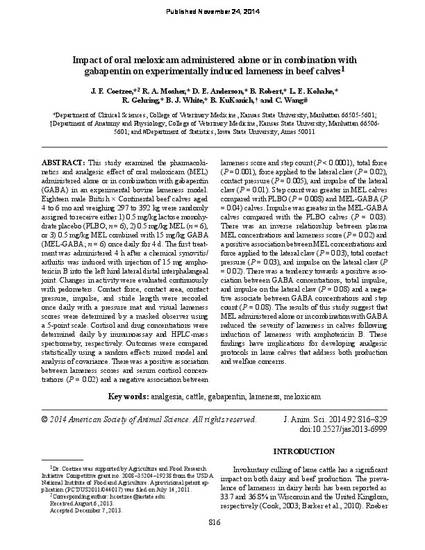
This study examined the pharmacokinetics and analgesic effect of oral meloxicam (MEL) administered alone or in combination with gabapentin (GABA) in an experimental bovine lameness model. Eighteen male British × Continental beef calves aged 4 to 6 mo and weighing 297 to 392 kg were randomly assigned to receive either 1) 0.5 mg/kg lactose monohydrate placebo (PLBO; n = 6), 2) 0.5 mg/kg MEL (n = 6), or 3) 0.5 mg/kg MEL combined with 15 mg/kg GABA (MEL-GABA; n = 6) once daily for 4 d. The first treatment was administered 4 h after a chemical synovitis/arthritis was induced with injection of 15 mg amphotericin B into the left hind lateral distal interphalangeal joint. Changes in activity were evaluated continuously with pedometers. Contact force, contact area, contact pressure, impulse, and stride length were recorded once daily with a pressure mat and visual lameness scores were determined by a masked observer using a 5-point scale. Cortisol and drug concentrations were determined daily by immunoassay and HPLC-mass spectrometry, respectively. Outcomes were compared statistically using a random effects mixed model and analysis of covariance. There was a positive association between lameness scores and serum cortisol concentrations (P = 0.02) and a negative association between lameness score and step count (P < 0.0001), total force (P = 0.001), force applied to the lateral claw (P= 0.02), contact pressure (P = 0.005), and impulse of the lateral claw (P = 0.01). Step count was greater in MEL calves compared with PLBO (P = 0.008) and MEL-GABA (P = 0.04) calves. Impulse was greater in the MEL-GABA calves compared with the PLBO calves (P = 0.03). There was an inverse relationship between plasma MEL concentrations and lameness score (P = 0.02) and a positive association between MEL concentrations and force applied to the lateral claw (P = 0.03), total contact pressure (P = 0.03), and impulse on the lateral claw (P = 0.02). There was a tendency towards a positive association between GABA concentrations, total impulse, and impulse on the lateral claw (P = 0.08) and a negative associate between GABA concentrations and step count (P = 0.08). The results of this study suggest that MEL administered alone or in combination with GABA reduced the severity of lameness in calves following induction of lameness with amphotericin B. These findings have implications for developing analgesic protocols in lame calves that address both production and welfare concerns.
Available at: http://works.bepress.com/chong-wang/34/

This article is from Journal of Animal Science 92 (2014); 816, doi: 10.2527/jas.2013-6999. Posted with permission.